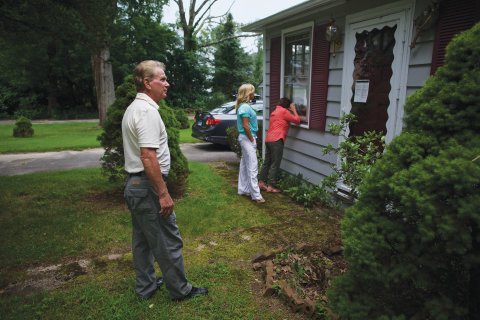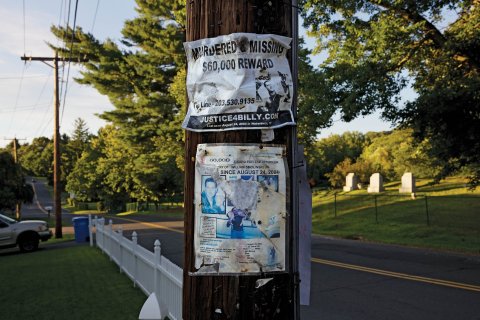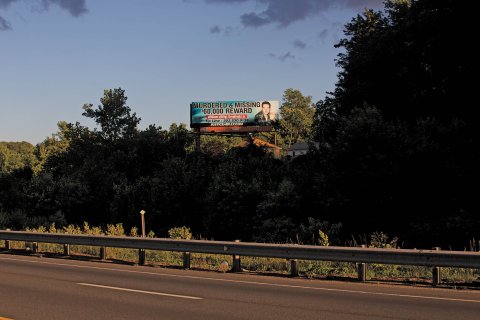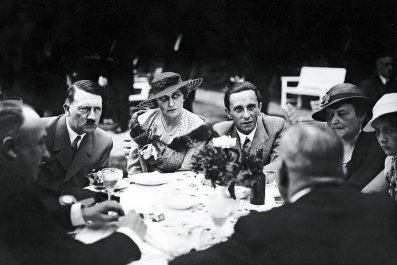Ten years ago, Billy Smolinski went away. Where he went, nobody knows. Nobody knows why he went there, if he went willingly. Nobody knows if he was killed or if he just skipped town. If he went into hiding, nobody knows where. Nobody knows why.
There was no Amber Alert for William P. Smolinski Jr., the way there would have been for a missing child. His picture was not on milk cartons. There is one billboard on I-84 in central Connecticut, placed above the busy thoroughfare by his parents. It says "Murdered & Missing; $60,000 Reward," next to a picture of Billy in a plaid shirt, hands clenched in resolution, meditation, maybe prayer. His lips are tough-guy sealed, his eyes meet the camera straight-on, but there is a hint of boyishness in his cheeks. There have been many tips over the last decade, repeatedly sending his parents deep into the woods of the Naugatuck Valley, a depressing dip in the land southwest of Hartford. But those tips haven't led to anything.
Billy Smolinski was 31 when he left his house at 130 Holly Street in Waterbury, Connecticut, on the afternoon of August 24, 2004. On that day, he joined the estimated 50,000 missing adults (18 or older) across America. To vanish is a remarkable feat in a society where even our most discreet movements are captured on social media and tracked by credit card swipes, where an estimated 30 million security cameras watch over our work and play. Yet people do it all the time, in what the criminologist Nancy Ritter calls, in reference to both missing children and adults, "the nation's silent mass disaster."
The predicament is compounded by poor communication between local and federal law enforcement, dismal funding for a national database of missing adult cases and a lack of interest from the media, as if a missing adult is less consequential than a missing child. "I don't think the public relates very well to someone who is just kind of a low-profile regular Joe, somebody who you can't really say anything terrific about," said Linda Pulliam in 2007, when her son Kurt LeBlanc vanished from a northern California ski resort. "I want to scream," she told the Los Angeles Times, "Damn it, why doesn't someone care?"
Jan Smolinski, a small, immensely intense woman, told me the same thing about her son when I met her and her husband in New Haven. "He was just a person," she said, "not an angel." A corollary went unspoken: that because Billy was a lower-middle class white male, seemingly ordinary in every way, he did not garner the attention and sympathy someone in a more compelling, mediagenic demographic might have. The Aruba disappearance of Natalee Holloway, a pretty 18-year-old blonde from a wealthy Birmingham, Alabama, suburb, still makes CNN once in a while, nine years after her doomed night at Carlos'n Charlie's. What made her, but not Billy Smolinski or Kurt LeBlanc, worthy of our attention, our prayers?
Like many families of missing adults, Pulliam was forced to conduct a search largely on her own, since Kurt did not appear to be the victim of a crime. Two years after he vanished, two hikers on the Lodgepole Trail (near Bear Valley Village, where LeBlanc lived) found human remains in a Maine sweatshirt, next to a Las Vegas Public Library mug. Pulliam knew at once that this was Kurt. A local newspaper, The Union Democrat, speculated that LeBlanc may have succumbed to his own "sometimes erratic behavior, which, some implied, may explain why he decided to follow a rough, wooded trail home on a drizzly day with low visibility rather than waiting for a ride."
Janice and William Smolinski Sr. have not been so lucky, in the wake of their great misfortune. They know their son is dead, but they still want him back.

"Watch Your Back"
William Smolinski Sr. met his future wife Janice Kenney on a beach in Thomaston, Connecticut, in 1968. They married and settled on the farm his family, Polish immigrants, owned in Naugatuck. They raised cattle, grew vegetables and tended to horses, a rural existence in a state far more famous for its posh suburbs than for its expansive farms. "It was really kind of an Amish way of living," says Jan. "We were very self-sufficient."
Billy graduated from high school, then went to Naugatuck Valley Community College for a year before dropping out. He worked blue-collar jobs, though his real love was repairing cars. He seemed neither aimless nor particularly ambitious, a young man content with the narrow confines of his world. In 1999, when Billy was 26, his grandfather passed away, and the family decided to sell the farm. The parents moved to Cheshire, Billy moved to Waterbury, and his sister Paula settled in nearby Wolcott.
In another age, Billy might have held down a good union job at one of Waterbury's many factories, which once made this city the Brass Capital of the World. Today, some in the Naugatuck Valley have it good, but few have it easy. There are pockets of wealth in the woods, but they are ringed by lower-middle-class enclaves where the houses are low and covered in vinyl siding and, farther out, approach the undiluted destitution of New Haven and Bridgeport.
Billy repaired cars, worked in towing, drove busses and dump trucks, mowed lawns. "He never got arrested or nothing," says his father, in the voice of working-class Connecticut only a generation or two removed from Ellis Island.
"Tough on the outside," William Sr. says.
"Mush on the inside," Jan amends.
Billy's house, at 130 Holly Street, is a one-story affair with an ample apron of green lawn. You could make a decent life there. Billy tried. But then, one summer afternoon, he asked his neighbor, Laroi Henley, to look after his German shepherd, Harley, because he was travelling north to look at some cars. That was the last anyone heard of him.
Just days before, he'd had an argument with his girlfriend, Madeleine Gleason, who was 16 years older and had five kids from previous marriages. Gleason met Billy when both were driving school buses for B & B Transportation, based in nearby Bethany.
"I don't know how the hell he came up with this girl, boy, I'll tell you," says William Sr. "We weren't too crazy about her." Nobody was sure what Billy saw in Madeleine, but when has that ever mattered? Madeleine was grieving for her daughter, Krystal Rapuano, who had recently committed suicide, while Billy had gotten out of a long relationship not long ago. He was in love with Madeleine, but she was not in love with him. Gleason is believed to have been carrying on an affair with Chris Sorensen, the married owner of a school bus company who was also a selectman for a nearby town.
On August 21, Billy and Madeleine travelled to West Palm Beach, Florida, where Gleason's son, Thomas Karpiuk Jr., a former Marine, worked in the security detail of the billionaire Nelson Peltz. Sometime during the long weekend, Billy appears to have discovered Madeleine talking to Sorensen on the telephone in the bathroom. Later, on the beach, he tried to take her phone, and she screamed for the police. They returned to Connecticut late that night, August 22.
On Monday, Billy met with his sister. "Billy said he was through with her," Paula Bell told The Waterbury Observer in 2006.
In the early morning hours of August 24, Smolinski put a ladder to Madeleine's house and climbed to her second-floor window (why he didn't just ring the doorbell or knock has never been adequately explained). She let him in and, she says, they argued. He wanted to get back together; she didn't. He left.
He apparently seethed for much of the day, placing three calls to Sorensen, the man with whom Gleason was allegedly having an affair. On the first two calls, he hung up without leaving a message. On the third call, he left an unambiguous warning: "Watch your back."
At 3 p.m., Billy ate at a Burger King in Waterbury, then came home and went to see his neighbor, Henley. Billy told him about his breakup with Madeleine and "asked me if I would watch his dog because he was going to go up north for a couple of days," according to a statement Henley gave to the Waterbury Police Department a year later. He never saw him again. Nor did anyone else.

"He Left on Horseback"
"Cut day" is every second Thursday in the sixth-floor Missing Persons Lab at the University of North Texas Health Science Center, which is on a museum-studded stretch of Fort Worth, Texas. Behind glass, five or six forensic specialists lift human remains out of blue pouches they call diapers. Some of the bones are long and large enough to easily suggest the part of an arm or a leg; others look like little more than ossiferous shards which may, nevertheless, contain the key to a long-lingering mystery.
For the next several hours, the high whine of bone saws emanates from behind the glass, as if a particularly industrious dentist were at work. Few forensic labs in the nation are as prolific in the DNA analysis of unidentified persons, with perhaps 30 remains logged each "cut day," a somewhat crude description of the intricate process that extracts DNA while leaving much of the bone—which, after all, could become evidence in a criminal case—intact.
To get at the unique genetic material that is responsible for each person's identity, the DNA analysts clean the bones by sanding them, then extract a small sample that is washed in bleach and ethanol solutions. This is eventually pulverized in a contraption that looks pretty much like a high-end salt grinder. The cells have yet to yield their DNA, which they only do once the bone powder is treated with extraction reagents, which help to "decalcify the bone and burst open the cells," explains Krystle Rodriguez, a DNA analyst at the UNT Health Science Center. The prize is not only the nuclear DNA that is the specific genetic signature of every person, but the more hardy mitochondrial DNA that is passed matrilineally and may also offer clues to identity.
This lab has analyzed the remains of victims from some of the nation's most notorious crimes, including those of Chicago serial killer John Wayne Gacy, successfully identifying one victim, and Seattle's Green River Killer. Its forensic specialists were sent to New York in the wake of 9/11, helping to identify those who perished in the towers' collapse, as well as to Chile to sift through the remains of the murderous Pinochet regime. Last year, it took the lead in trying to identify the remains of boys from unmarked graves at Florida's notorious Arthur G. Dozier School for Boys.
Yet Arthur J. Eisenberg, director of the University of North Texas's Center for Human Identification, bristles when I suggest his lab is bringing closure. "I don't know what closure means," he says in his New York accent. "My job is to convey information." His goal is to match DNA extracted from the remains to the vast storehouse that is the federal Combined DNA Index System (Codis), which includes so-called family references samples of those looking for missing relatives. He is a matchmaker of the exceedingly morbid variety.
In addition to the missing persons lab, the University of North Texas oversees the National Missing and Unidentified Persons System (NamUs), a "clearinghouse for missing person cases, unidentified victims, unidentified living individuals and unidentified bodies," a sort of digital public wall upon which information is posted for all to see and sift through: a cop in Massachusetts, a coroner in Florida, a basement sleuth in Nebraska (not everything is visible to members of the public).
With the National Institute of Justice providing about $2.2 million in funding, the seven-year-old NamUs has logged a total of 31,369 cases, a searchable list of the missing and unidentified that anyone can browse in hopes of solving a case. B.J. Spamer, who runs NamUs with a staff of 17, says it has been responsible for the direct resolution of 700 missing person cases, though she believes the number could be higher because of imprecise reporting procedures that sometimes don't give credit to the database.
The oldest open case in NamUs is that of Elijah Cravens, who disappeared in 1902 from Okmulgee, Oklahoma: "He left on horseback to attend a Woodmen of the World meeting and was never seen again," according to the NamUs narrative. His remains have now evaded detection for more than a century. The oldest case that appears to have been solved through NamUs was that of Ora Kellett, who vanished from Miami County in Ohio, in 1959. After her daughter entered her mother's information into NamUs, law enforcement agencies recognized the details, and a match was made.
"We want every law enforcement agency in here," Spamer says. This is, essentially, crowdsourced detective work. The more people use NamUs, the more useful it will be.
Type in "Billy Smolinski," and the basic stuff comes up: 6 feet tall, 200 pounds, a tattoo on his left shoulder, another on his right forearm, an earring in his left ear. Bowlegged.
The hope—for Billy's parents, for so many other families—is that, outside a DNA match being made in the missing persons lab, someone scrolling through the database might make a connection that could finally bring the missing home.
Like many of the people I spoke to for this article, Eisenberg, director of the missing persons lab, wishes that the cops took missing adults cases more seriously, instead of resorting to the explanation (or excuse?) that grown men and women have the freedom to vanish. Few of those who arrive in Fort Worth have exercised that right willingly. "People typically don't wander off into the woods and die," he says.

"They Dug a Hole"
"Connecticut is just bizarre," says John Murray, editor and publisher ofThe Waterbury Observer, which has assiduously reported on the Smolinski case for 10 years. He says the Naugatuck Valley is a "hardscrabble place and a tough place." It is also the home of some of Connecticut's most infamous crimes. Cheshire, where the Smolinskis live, entered the national news on July 2007 when two felons violently invaded the home of endocrinologist William Petit, killing and sexually assaulting his wife and two daughters before setting the house on fire. Five years later, in nearby Newtown of northeastern Fairfield County, a deranged 20-year-old used his mother's arsenal of guns to kill 20 children at the Sandy Hook Elementary School, along with six adults.
Burdened by plenty of other troubles, the Waterbury Police at first did not treat Smolinski's disappearance as a high-priority crime. He was, after all, an adult who could come and go as he pleased, and you couldn't blame a man who still had several years of youth left to yearn for escape from Waterbury. One detective suggested Billy was in Europe, "having a beer," an image at once pleasing and deeply misguided.
"They didn't take it seriously," Murray says of the police. For example, Billy's truck was left at the edge of his driveway, "a place he never parked" according to Jan. That alone should have been a sign that something was wrong. His wallet and keys were tucked into a seat, further evidence that he wasn't on a European vacation.
Not that there were many leads. The refrain Jan heard in those early days, when time was of the essence, was No body, no case. That is, the cops needed a credible reason to believe Smolinski had been murdered. The Smolinskis had no such doubts—they feared Billy had been the odd man out in a love triangle. They heard rumors that one of Madeleine's sons killed Billy (later, they learned that the police had heard the same thing). Jan estimates that as many as 300 people searched in the woods for Billy's remains, with private investigators coordinating the effort. Search dogs went out every weekend until the snows fell.
A break appeared to come in 2006, when a confidential informant told cops that back in 2004, he was sitting in a Dunkin' Donuts with another man when the two of them spotted the ubiquitous "missing" posters the Smolinskis had tacked up throughout the valley. The informant said that the other man told him, according to a police report, "[Shaun Karpiuk] killed Billy because Billy beat up [Shaun's] mother, Madeleine Gleason. [The informant] stated that [Shaun] supposedly choked Billy and killed him when they were in Madeleine's apartment. [Shaun] then called his friend Jason Lee and they buried Billy at a job [site] that [Shaun] was working at... He stated that they dug a hole and buried Billy under a spot that concrete was poured [over] the next day."
Neither the cops nor the Smolinskis could question him, because he was dead. Just five months after Billy disappeared, Karpiuk and two friends went to buy $60 of heroin from someone named Chino. According to Waterbury Police Department records, "immediately following that transaction, the trio used said heroin."
A few minutes later, one of them flagged down an ambulance. "The ambulance workers stated that they drove over to the red car in the lot and noticed a while male lying across the front seats of the car." Shaun was breathing shallowly and had an abrasion above his right eye. By the time he was delivered to the Waterbury Hospital, he was dead.
The Smolinskis had long asked the Federal Bureau of Investigation to get involved in their son's case, having figured that the Waterbury Police Department didn't care or didn't have the resources to care. In October 2006, the FBI's New Haven office decided to take charge of the case. "We've been crying for help for two years and almost everybody has pushed us aside," Jan said at the time. "Having the FBI take a look at Billy's case is a breath of fresh air. Maybe they are the answer to the chaos we've been dealing with."
But it was two years until there was another solid lead, and that was when Chad Hanson, one of the three men in that Ford Escort, decided to talk. He told officers he "he did not kill Smolinski, but he did help Karpiuk bury the body." The FBI and local law enforcement searched in towns like Shelton and Seymour, sometimes digging up football field–sized parcels where Hanson said he and Karpiuk had laid Billy to his uneasy rest. They found nothing and concluded that Hanson, who has an impressively long arrest record, had lied, perhaps having become skittish about being associated with a murder. Hanson is now in prison in Connecticut for making false statements to law enforcement. He has refused to meet with the Smolinskis and did not respond to my request for an interview.
I went to one of the sites where cops searched for Billy's body, near the Waterbury-Oxford Airport, expecting a weedy suburban lot. Instead, I found myself in a heavily wooded area thick with trees and brambles, precisely the kind of place you might seek out if you hoped to bury a body. Even if Hanson had led the cops here in good faith, it would have been a challenge to find anything in this dense wilderness. The only sign of human activity was a "missing" poster for Billy stapled to a telephone pole.

"He Was Doing Bad Things"
"They used to saturate the whole area," Madeleine Gleason complains about the posters that started appearing right after Billy went missing. They went up in Waterbury and Milford, Shelton and Ansonia. New Haven. Naugatuck. Bus stations, gas stations, supermarkets, trees. Billy Smolinski was suddenly everywhere, even as he was nowhere.
We are sitting on black leather couches in her cool, comfortable living room in a small Connecticut town whose name Gleason has asked me not to reveal. "They used to put them on my car," she says of the posters. In 2005, Jan Smolinski was arrested for putting up posters at a school where Gleason dropped off and picked up kids. The following year, Gleason sued Smolinski for harassment and has won $52,666 in damages for defamation and intentional infliction of emotional distress; an appeals court upheld up the verdict last spring, but the Connecticut Supreme Court has agreed to hear the case.
Gleason has not had an easy life. Of her five children, three are dead: Krystal from suicide; Shaun from a heroin overdose in 2004; Tom, in 2008, drowned in calm waters off eastern Long Island, despite being a former serviceman and excellent swimmer. Another son is in prison.
"I never talk to anybody," she told me. A large yellow school bus was parked outside: Gleason still drives for B&B Transportation.
Gleason, middle-age, tanned and blonde, looks like someone who spends a lot of time in Florida. Many of her appendages are adorned with rings. Her accent is strikingly similar to that of William Smolinski Sr., her nemesis. Accordingly to Gleason, the Smolinskis did not really know their son. "He was doing bad things," she says, alluding to "anger issues." She says that while Billy was "in love with me big-time," she saw their relationship as nothing more than a fling. "He was just too young for me," she says, exasperated.
"I would tell you if my son did it," she says when I ask about Shaun Karpiuk's alleged involvement, estimating that the two men met fewer than half a dozen times. Chad Hanson, she says, invented the story about Shaun killing and burying Billy: "I don't think he is lying; I know he is lying." She believes that Billy is "a survivor" who could be living in the woods somewhere.
To the Smolinskis, she has a blunt message: "You have ruined my life," she says bitterly, while outside the yellow school bus gleams under the afternoon sun like a hypertrophied slice of melon. Soon, there will be children to pick up from school.

Unspeakably Dark Hours
In 2010, then-Congressman Chris Murphy, a Democrat from Connecticut, sponsored, with Republican Congressman Ted Poe of Texas, "Billy's Law." Officially known as the "Help Find the Missing Act," it would provide a measly $10 million per year of federal funding to make sure law enforcement agencies across the nation had some basic guidelines on how to report, look for and identify missing adults. It would also support NamUs and link it to the FBI's National Crime Information Center, thus widening its reach.
The bill passed the House, but the 111th Congress ended in December without a Senate vote. When legislators returned to Washington, the House was back in Republican hands and, with the ascendant Tea Party having pushed the GOP far to the right, there was no appetite for compromise of any kind. "Republicans have become allergic to putting new programs into law," Murphy, now Connecticut's junior senator, says, citing the Republicans' "irrational fear" of government spending. "There was a real federal solution at hand," he says. "We know this bill is not that controversial." Nevertheless, it's dead for now.
There have been objections to Billy's Law from law enforcement, as well. Several years ago, then–West Hartford police chief James J. Strillaci took to the pages of The Connecticut Mirror to argue against a similar measure being passed in Connecticut. "Mrs. Smolinski has a mission," he wrote. "Police departments have many missions." He called her proposed guidelines for missing-adult searches an "unfunded list of duties" that could lapse into the "absurd" if mandated by law.
"We all need to do better," says Monica Caison founder of the CUE Center for Missing Persons in Wilmington, North Carolina. She says that she has recently noticed law enforcement agencies taking missing adult cases more seriously, for example using social media to raise awareness about someone who has vanished. She says nothing harms the chances of finding missing adults more than the "invisible waiting period" imposed by some police departments, delaying a search for several days before declaring someone missing. Usually, if a person is found, it is in the first 48 hours after he or she disappears.
About 87,000 hours have passed since Billy Smolinski disappeared, unspeakably dark hours of anguish for his parents. They are certain their son is dead. All they want now is to find what remains of his remains. Though it has been 10 years of searching, they remember each misstep by the Waterbury Police Department, each poster torn down by Madeleine Gleason, each false lead that only uncovered a decomposing deer carcass, as if it were yesterday.
Tips keep coming in through the Smolinskis' tip line. In May, just before I met with Jan and William Sr., they had gone out with a cadaver dog who led the search party to "a spot near a body of water and barked," according to the New Haven Register. But the Waterbury Police Department—which has sole jurisdiction of the case again—refused to search the area.
And so the Smolinskis keep searching on their own, because nobody else will.



























